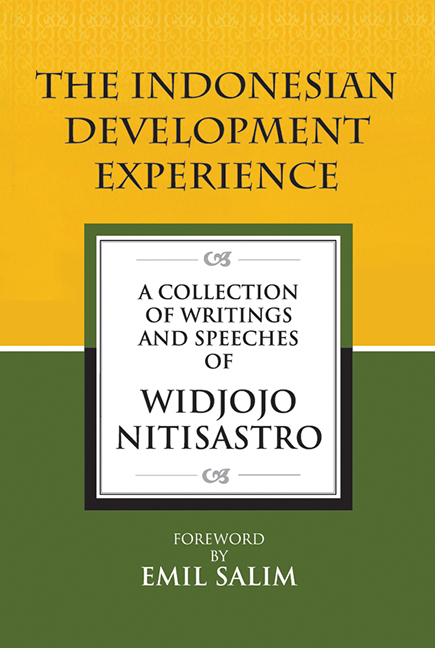Book contents
- Frontmatter
- Dedication
- Frontispiece
- Contents
- Foreword
- Introduction
- Part I PLANNING OF INDONESIA'S DEVELOPMENT
- Part II IMPLEMENTATION OF INDONESIA'S DEVELOPMENT
- Part III FACING VARIOUS ECONOMIC CRISES
- Part IV SETTLEMENT OF FOREIGN DEBT
- Part V EQUITABLE DEVELOPMENT
- Part VI INDONESIA AND THE WORLD
- Index
- About the Author
Foreword
Published online by Cambridge University Press: 21 October 2015
- Frontmatter
- Dedication
- Frontispiece
- Contents
- Foreword
- Introduction
- Part I PLANNING OF INDONESIA'S DEVELOPMENT
- Part II IMPLEMENTATION OF INDONESIA'S DEVELOPMENT
- Part III FACING VARIOUS ECONOMIC CRISES
- Part IV SETTLEMENT OF FOREIGN DEBT
- Part V EQUITABLE DEVELOPMENT
- Part VI INDONESIA AND THE WORLD
- Index
- About the Author
Summary
As Indonesia entered the 1960s, its economy nosedived into an alarming exponential degradation. The cost of living index in Jakarta hit 100 per cent per year from 1962–64 before “shooting up” to 650 per cent from December 1964 to December 1965. The prices of daily necessities went up every day and Indonesia was trapped in spiral hyperinflation.
Building the nation
The main reason behind the hyperinflation was the uncontrollable increase of the volume of money driven by a deficit in the State Budget. There was a strong linkage between the increase in the deficit and the overflowing volume of money. Even if some 45 per cent of the total State Budget were to be channelled for military purposes, the impact on the economy in terms of increasing the flow of the volume of goods and services would not be that big. Its impact on boosting state revenue would be equally insignificant because most of the revenue would be spent on war preparation. The problem was the combination of the bulging revenue deficit, the allocation of revenue for unproductive purposes, and the rise of the volume of money. These things together had triggered the hyperinflation.
The trade and service balance of payments in the 1960s also showed an alarming rise in deficit. As exports and imports dropped, there was a need to repay our foreign debts. All of these things had nibbled into our foreign reserves which tumbled from US$326.4 million (1960) to US$8.6 million (1965).
Almost half of the total US$2.4 billion in foreign debts was spent by the Indonesian Armed Forces (ABRI), making it a power to be reckoned in terms of military equipment, weapons, fighter jets and warships, a leading edge for a developing country with a meager income. But this was unavoidable because the head of state had made a political decision to prepare for a war to win West Irian back into Indonesia's fold. Later, the “crust” Malaysia policy, was adopted. The war drums were then beaten even harder to fight the “Capitalist and Imperialist Blocks” in the then Cold War era.
In this “war economy” situation of the 1960s, emotions were fanned and patriotism whipped up. It was during this time that Sukarno embarked on nation and national character building, a process through which the minds of the people were infused with thoughts of nationhood and singular awareness of the motherland.
- Type
- Chapter
- Information
- The Indonesian Development ExperienceA Collection of Writings and Speeches, pp. xi - xxivPublisher: ISEAS–Yusof Ishak InstitutePrint publication year: 2011



